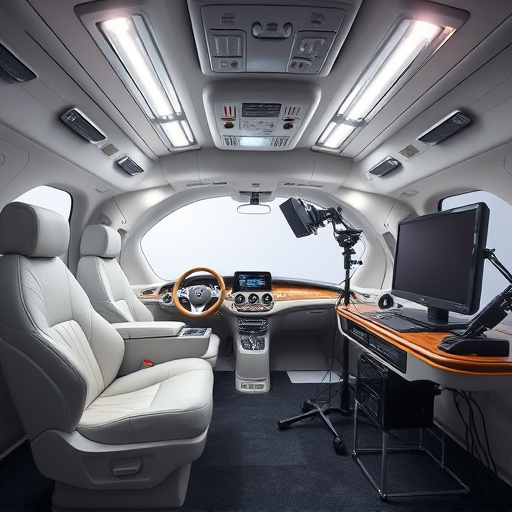Advanced heat shield technology and cold air intake systems work synergistically to manage underhood temperatures, optimizing vehicle performance and component longevity. Heat shields reflect and absorb excess heat, while cold air intakes draw in cooler external air for enhanced combustion efficiency. This balanced approach ensures optimal engine performance and safe operating temperatures across diverse driving conditions. Measuring temperature differentials with advanced sensors is crucial for engineers to fine-tune vehicle design and thermal management strategies.
In the pursuit of automotive efficiency, understanding and managing underhood temperatures is paramount. This article delves into the intricate dynamics of underhood temperature reduction, exploring how components like heat shields and cold air intakes play pivotal roles in keeping engines cool. We examine advanced measuring techniques and unveil strategies for optimal cooling, emphasizing the benefits of cold air intakes in enhancing engine performance and longevity. Discover insights that empower both professionals and enthusiasts to navigate the landscape of temperature control effectively.
- Understanding Underhood Temperature Dynamics: Heat Shield and Air Intake Role
- Measuring Underhood Temperature Reduction: Techniques and Tools
- Strategies for Optimal Underhood Cooling: Applications of Cold Air Intakes
Understanding Underhood Temperature Dynamics: Heat Shield and Air Intake Role

Underhood temperature dynamics are a complex interplay of various components, with heat shields and cold air intakes playing pivotal roles. Heat shields act as a barrier, reflecting and absorbing excess heat from the engine compartment, thereby reducing the overall underhood temperature. By minimizing direct sunlight exposure and retarding heat transfer from hot components, these shields help maintain optimal conditions for sensitive parts.
Cold air intakes, on the other hand, facilitate the intake of cooler external air into the engine. This cold air is denser and contains more oxygen molecules, enhancing combustion efficiency. By drawing in ambient air from outside the vehicle’s interior, where temperatures are typically lower, these intakes contribute significantly to lowering underhood temperatures. The combination of heat shields and cold air intakes creates a balanced ecosystem, ensuring that the engine operates at its best while maintaining a healthy, safe temperature range under all driving conditions.
Measuring Underhood Temperature Reduction: Techniques and Tools

Measuring underhood temperature reduction involves a combination of advanced techniques and specialized tools to accurately assess the effectiveness of cooling strategies in automotive environments. One key method is utilizing heat shield technology, which acts as a barrier between hot components and the surrounding underbody. These shields are designed to reflect and dissipate heat, reducing the overall temperature of the engine compartment. By integrating reflective surfaces and advanced materials, engineers can significantly minimize heat transfer, creating a cooler microclimate beneath the vehicle’s hood.
Additionally, cold air intakes play a crucial role in enhancing temperature reduction. These systems draw in ambient air from areas where it is relatively cooler, such as below the vehicle or through strategically placed vents. By directing cold air directly into the engine, these intakes contribute to lower combustion chamber temperatures, thereby reducing heat buildup in the underhood space. Advanced sensors and thermocouples are employed to measure temperature differentials, allowing for precise evaluation of cooling performance. This data is invaluable for engineers aiming to optimize vehicle design and enhance overall thermal management.
Strategies for Optimal Underhood Cooling: Applications of Cold Air Intakes

To achieve optimal underhood cooling, several strategic approaches can be employed. One effective method is the utilization of heat shields, which are designed to reflect heat away from the engine bay and underhood components. These shields act as a barrier, minimizing the impact of direct sunlight and ambient heat on sensitive parts. By reducing the overall temperature in the underhood area, the performance and longevity of various components can be significantly enhanced.
Cold air intakes are another application worth noting. This system draws in cooler external air, bypassing the engine compartment to deliver a more substantial supply of cold, dense air to the engine. Such an approach not only improves engine performance but also directly contributes to underhood temperature reduction. By incorporating cold air intakes, vehicles can experience better cooling capabilities, especially during high-performance driving conditions or in hot climates, ensuring optimal operating temperatures.
By understanding the intricate dynamics of underhood temperature and leveraging advanced measurement techniques, automotive engineers can optimize cooling systems. The strategic implementation of heat shields and cold air intakes plays a pivotal role in reducing engine compartment temperatures, ensuring optimal performance and longevity of vehicle components. This knowledge empowers manufacturers to create more efficient, eco-friendly vehicles while maintaining peak operational standards.














